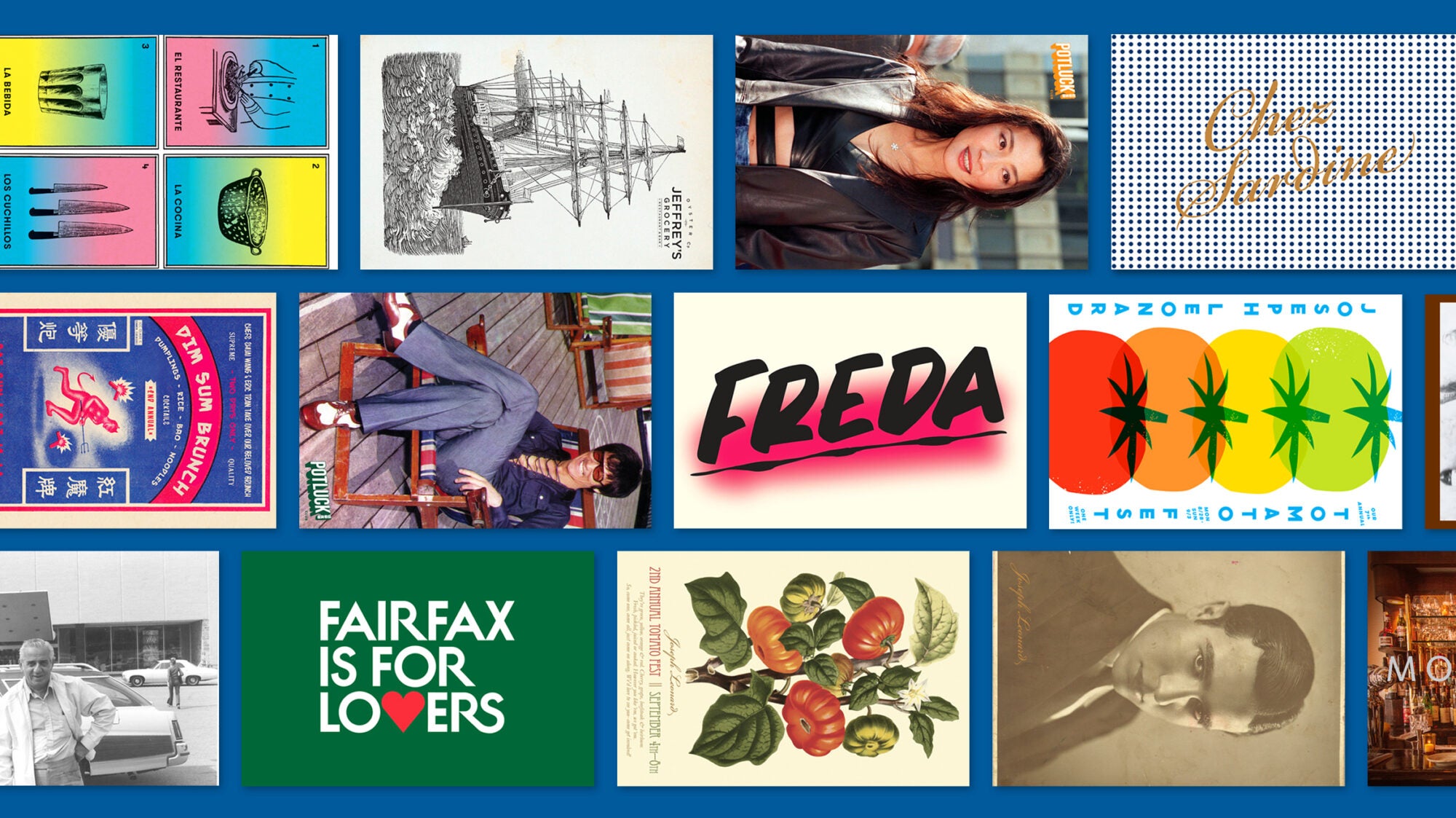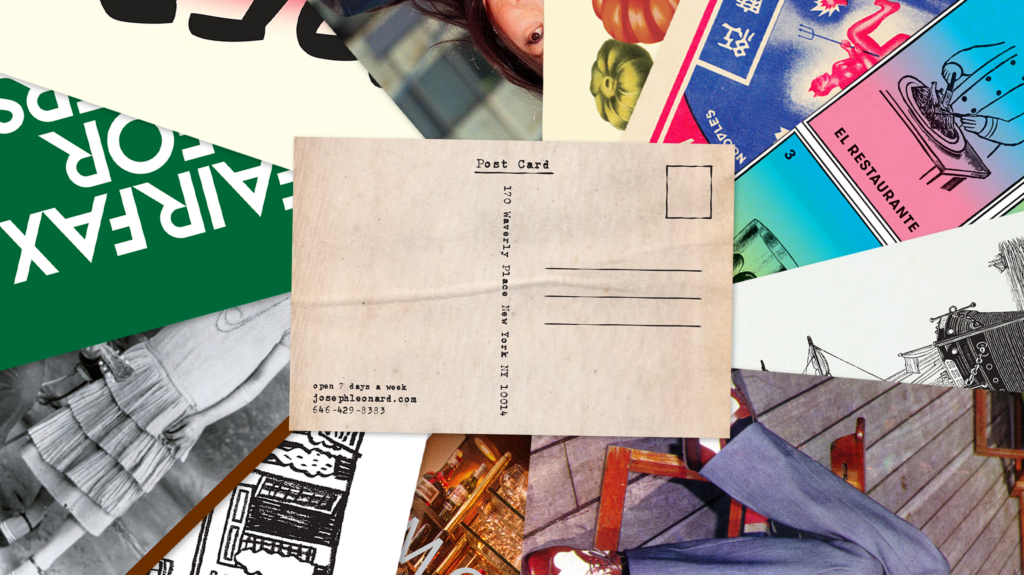
In this digital era of QR code menus, the restaurant postcard finds renewed purpose—and fans.
After the final bites of tiramisu—the leftover coffee cream and cocoa powder dust all but licked off the plate—I eagerly await the bill. It’s not because I’m excited to assess the damage from dining out (I certainly am not). Rather, I’m anxious to see whether the check might be presented with a complimentary postcard to join my growing collection. Once I see the server lay the solid piece of cardstock down on the table along with the flimsy receipt, I’m elated to be continuing a long dining tradition with a surprising backstory.
Before artfully designed tote bags and graphic tees marked a boom in restaurant swag, there were postcards. Starting in the early 20th century, postcard culture swept across America, and restaurants in bigger cities saw an opportunity to capitalize on the tourists and business travelers passing through with a free postcard advertising their business. “The restaurants hoped that it would make their restaurant better-known and draw more guests,” says Jan Whitaker, restaurant historian, avid postcard collector, and author of the blog Restauranting Through History. Though far from their heyday in the early 1900s, when postcards were on display in every store window and collecting them was a popular American pastime, more contemporary casual dining spots have been bringing this seemingly antiquated souvenir back to their dining tables as a touch of hospitality that doubles as a marketing boost.
I used to stick the 4×6 prints—a quirky illustration of the Jack’s Wife Freda SoHo storefront and friendly neighbors, a purple cartoon octopus chef serving sake and bowls of noodles at Ivan Ramen on the Lower East Side, what appears to be French vaudeville-era art from La Grande Boucherie—on my wall. It was a gallery of my dining conquests, held together by renter-safe painter’s tape. These days, I prefer to use the cards for their intended purpose: mailing them out to friends who would have enjoyed the meal or will appreciate the image on the card. According to the US Postal Service, the number of mailed stamped cards and postcards decreases by an average of 7.9 percent per year. It has dwindled from over three billion in 1997 to around 325 million in 2024. But even as the mail rate decreases, restaurants are seeing the opposite overall effect—a renewed interest in the format.
Gabriel Stulman, CEO of Happy Cooking Hospitality, the group behind the New York City restaurants Sailor, Fairfax, Joseph Leonard, and Jeffrey’s Grocery, points out that there are several popular ways restaurants can choose to present their checks. “I’ve seen it rolled up in a glass. I’ve seen it delivered in some leather folding book,” he says. “I’ve seen people have nice, heavy stock stationery that has almost like a little envelope insert. I’ve seen people bring it on a miniature clipboard. I’ve seen it on a silver tray. I’ve seen some places that don’t bring it, and they just bring me their little iPhone.” But the postcard in particular, which servers present face up with the check paper-clipped under it, speaks to the restaurateur. Aside from its function, it scratches an “intrinsic itch in [his] love of design.”

Stulman has printed multiple iterations of postcards for his first restaurant, Joseph Leonard, which opened in 2009. It has varied from portraits of Stulman’s grandfathers, Joseph and Leonard (for whom the restaurant is named), to recipes for dishes, such as its salted caramel pudding, and a few short runs of cards with posters promoting restaurant events over the years. Fairfax’s postcards feature cartoon foxes; seafood and oyster bar Jeffrey’s Grocery has nautical-themed art; and bold, modern graphics are the design choice for the group’s newest restaurant, Sailor, which opened its doors in Brooklyn in 2023.
It’s unclear who started this trend in the United States, but some New York City operators tip their hat to Keith McNally, the British restaurant legend behind Pastis and Minetta Tavern, who is credited for helping define the dining and social scene in downtown Manhattan. Jack’s Wife Freda co-owners Dean and Maya Jankelowitz certainly took a cue from McNally after both working at his restaurants—at Schiller’s and Balthazar, respectively. “Having [a postcard] on the check presenter just feels very whimsical and cute,” says Dean.
Before artfully designed tote bags and graphic tees marked a boom in restaurant swag, there were postcards.
McNally mentions in his 2025 memoir that he was fond of buying vintage postcards. He writes that, by the end of the 1970s, he had amassed a collection of over 500 of them. But it was his former business partner and ex-wife, Lynn Wagenknecht, who suggested creating a postcard as a check presenter for the newly opened Café Luxembourg in 1983. McNally in turn made producing the initial card a major creative endeavor. Instead of a photo of the restaurant’s interior, like Wagenknecht suggested, McNally took inspiration from a vintage Brassaï photo card and staged a photo shoot. Initially, the restaurant’s general manager hired women that, in McNally’s words, “looked like Vogue models.” He was “appalled” and called the modeling agency to reschedule the shoot for the next day, telling them to cast three everyday “real” women to pose naked in front of Café Luxembourg’s bar instead.
McNally has long since sold his shares in the restaurant, but still he writes, “It’s worth visiting Café Luxembourg just to see this photograph.” Recently Café Luxembourg released a new, illustrated version of its iconic postcard, depicting three women sitting in a martini glass. The restaurateur has also been using postcards to promote his book at his restaurants, like Balthazar and Minetta Tavern.
Rivka Orlin opened Café Mogador in the East Village in 1983 as well, and it was only natural for her to have postcards and matchbooks like the McNally establishments and other restaurants at the time did. Her plan was to share a piece of her family’s history, especially since the restaurant’s menu of mezes and tagines is based on her mother’s Moroccan cooking and the warmth and love her parents shared. She printed postcards with her favorite photo of her parents, taken in Mogador, Morocco, in 1935—her mother looks fashionable in a tiered, drop-waist, ’20s-style day dress, and her dapper father is playing the mandolin.
“People love that picture, and they keep it,” Orlin says. On one trip to Paris roughly 15 years ago, and on a separate one to Costa Rica, she recalls having spotted the Café Mogador postcard in the homes of people she’d only just met. “It’s a very good advertisement for the restaurant, but that wasn’t the reason I did it. The reason is because I loved it, and I thought it’s an extra gesture to give people this picture.”
Stulman echoes these sentiments, saying that while the check presenter aspect is the “service” portion of the postcard, it’s this idea of giving people something either to keep and cherish or to mail out to a loved one that makes it “hospitality.” (Stulman says his restaurants are happy to send any postcards that are addressed by customers and left at their tables, although few people know this and it rarely happens.) According to several restaurants I spoke with, the budget for postcard printing and paid postage varies from upward of $1,000 to over $24,000 in a year, without taking into account the cost of design.
“It’s worth visiting Café Luxembourg just to see this photograph.”
“Most people don’t take the postcard. But for the ones who don’t take it, there’s the other bunch who take a handful,” says Dean Jankelowitz, with some customers grabbing more than a few from the stack of postcards that sit in the front area of their restaurant, beside the matchbooks. I, of course, count myself as part of that latter bunch. I’ll never forget (and my boyfriend will never let me forget) that after a 21-course omakase and dessert at the Office of Mr. Moto in the East Village in 2024, I abused the hostess’s generous offer to send their beautiful, gold-foiled, blind-embossed postcards (created in partnership with hospitality design firm Polonsky & Friends) anywhere around the world. I wrote and sent a total of five—one to the Philippines, another to Australia, and three to friends living in different US states—which they happily stamped and mailed out. The cost of international postage didn’t come close to making up for the cost of the meal, but I certainly felt like it did.
This is what restaurant postcards are for: to help create a lasting impression until the very last moment, even after dessert is served. “We didn’t want to just leave a check and [have it feel] boring,” says Cory Ng, co-owner of New York’s Potluck Club, which opened in 2022. Ng and his partners wanted something special that called back to their childhoods and to Asian American culture. So they designed collectible postcards reminiscent of trading cards, featuring Cantonese pop culture icons and heroes like Bruce Lee, Jet Li, Michelle Yeoh, and Jackie Chan.
“For the people who know, it just kind of strikes that chord in your heart,” says Ng. And that, to him, is worth the investment. They’re going to keep the postcards coming for the foreseeable future.
Helping keep the tradition of postcards alive is an unintentional upside, but McNally tells TASTE, through an email from his book agent, “I think my restaurants’ postcards are less of an important detail than the final, gossamer-thin layer to the customer’s overall experience.” Still, and partly because of McNally’s restaurants and their legacy, postcards are a small detail in hospitality that hasn’t gone unnoticed—an extra treat that, while inedible, lasts far longer than dessert.